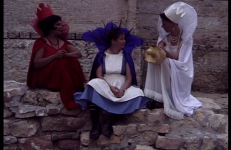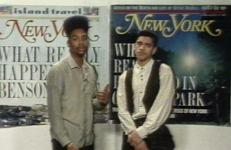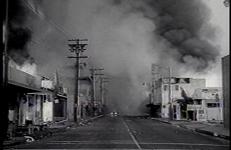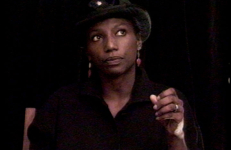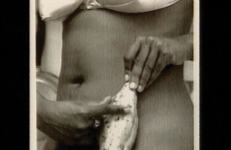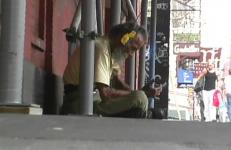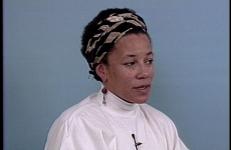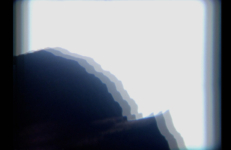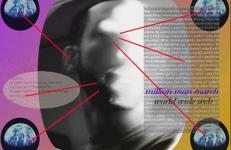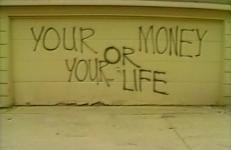Half-breed Alice attempts to become queen and struggles with the Red Queen and the White Queen's disapproval of her racial transgressions. A funny and quirky take on race, starring Cosmosquaw as the Red Queen, Shawna Dempsey as the White Queen, and TJ Cuthand as Alice.
Race
Danny Tisdale is a performance artist from New York City. His performances challenge prevailing ideas of race, assimilation, appropriation and success by offering passers-by the chance to racially change their appearance as a means to achieve greater financial success. The mimicry of museological practices of cataloguing and preservation, display and presentation provides one of a range of rhetorical frameworks upon which Danny Tisdale hangs his practice of social critique.
Using Paper Tiger's unique style of direct address and deconstruction, teenagers from the Bronx ask questions and try to understand the persistence of racial violence in the 1990s. Black and Latino students give a sharp and insightful comparative analysis of the newspaper coverage of two events that were especially traumatic for their community: the January 1990 murder of Yusuf Hawkins by a mob of 30 whites in Bensonhurst, and the Central Park "gang rape" of a white woman by a group of black youth.
This work was produced in connection with Icono Negro, a three-artist show at Long Beach Museum of Art exploring the dynamics and distinctions of black video art. Three works featured in the show—Tony Cokes’s Black Celebration, Philip Mallory Jones’s What Goes Around, and Lawrence Andrews’s An I for an I—are shown in their entireties and commented upon by curator Claire Aguilar and video artists Ulysses Jenkins and O. Funmilayo Makarah.
Michele Wallace's attention to the invisibility and/or fetishization of black women in the gallery and museum worlds has made possible new critical thinking around the intersection of race and gender in African American visual and popular culture, particularly in what she has called "the gap around the psychoanalytic" in contemporary African-American critical discourse.
This video was originally part of an installation at the Whitney Museum of American Art, part of which included the video collaboration Channels of Desire. Recreating coin-operated porno booths, Channels aired one photo image on seven TVs, interrupted only by the viewer inserting a coin and choosing a segment. The concept behind it was the construction of desire in categorical ways, the form of the piece speaking to sexual desire as something that is constantly evading the viewer. The images presented women’s experiences with interracial, lesbian, and heterosexual encounters.
White Balance (to think is to forget differences) is an effort to uncover the geographies of power, the frontiers of privilege. It revisits this problem from different angles, creating short circuits of meaning which are hosted by improbable audiovisual matches. Media and internet footage is intermixed with images shot in downtown Manhattan before and after the September 11th attacks.
Linda Williams writes on what she calls “body genres”: melodrama, horror, and, most famously, pornography. One of the most influential feminist film scholars to emerge in the 1980s, she wrote important essays on the women’s film (melodrama) before publishing her most influential work, Hard Core: Power, Pleasure, and the Frenzy of the Visible (1989 and 1999).
Pat Ward Williams’s socially charged works confront issues of race, often dealing specifically with African American history and identity. Using a variety of photographic processes, video, audio tapes, assemblage and text, Williams layers meanings and images. Her subjects range from the autobiographical to the public, often combining documentary techniques with personal responses. “When I make photos about my family, I think my family is not a lot different than other peoples’ families, so that is a way people can access my work...
Witness is a perceptual meditation on police brutality—specifically a power dynamic that law enforcement has coined “suicide by cop.” Filmed in Iceland on 8mm film, the film hinges on archival audio—unfolding in real time—of a young Black man negotiating his life with the police out of frame. Repeatedly asking for the camera, he foreshadows the camera as a potential witness in his final moments, appearing hyperaware of the possibility of being erased or silenced from history.
This interactive CD-ROM asks the question "What is the difference between a community based on identity and identity based on community?" Broken down into four central areas: desire, spirit, identity, and pleasure, World Wide Web/Million Man March suggests the fluidity of "race and place" at play, yet denied, in contemporary dialogues centering on technology and emergent social bodies. One area of misplaced cultural rhetoric is the paranoia and utopia attributed to both the Internet and Black masculine activist practices.
Your Money or Your Life is a video essay on street crime, and on the role played by an atmosphere of pervasive (white) urban fear in structuring and renewing racial antagonism and inequality. At the center of the video is a young, white, middle-class woman caught in an ideological trap in which her genuine fear, whetted and animated by the media, becomes synonymous with racial suspicion and hostility. Her counterpart is a black mugger, who tells a story of unemployment, powerlessness, ambition and cynicism, unmasking an ethos not dissimilar to the ethos of American capitalism.




